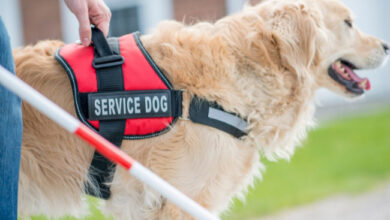
emotional support animal is a relatively recent accommodation for those who need them, and there is a significant misunderstanding about the rules and regulations regarding ESA. We’ll discuss the laws and regulations that do apply the emotional support animal. And we’ll address the scams that some fall prey to because they think these things are necessary to take their emotional support animals with them.
What is an Emotional Support Animal?
An emotional support animal is one that provides assistance regarding psychiatric or intellectual disabilities. The most common emotional support animal is an emotional support dog, though other animals have received this designation. For example, miniature horses have been trained as guides for the blind.
Emotional support animals are not trained in the same way service animals are. Service animals are trained for a specific task, such as helping someone navigate streets or alert an owner and those nearby that someone is having a seizure.
Emotional support animals must be well behaved in public and follow basic commands. This is why you don’t see “emotional support cats” – they don’t come back to you when called or sit and stay while you approach. Your cockatiel or turkey can’t respond to commands, so it cannot receive a valid ESA designation. The law specifically excludes snakes, all other reptiles, ferrets, rodents.
Why Do People Want Emotional Support Animals?
Real emotional support animals provide a valuable service to the owner. It may relieve anxiety, PTSD or autism symptoms without medication, allowing the person to function in a variety of situations in which they’re otherwise limited or unable to deal with. Unfortunately, some people try to label their pets as emotional support animals because ESA along with other service animals are allowed in place generic pets are not. Then there are the many laws that protect emotional support animals and their owners.
How Can You Get an Emotional Support Animal?
If you want to know how to adopt an emotional support dog, know that it isn’t as difficult as finding a trained service animal. That is typically done through nonprofits and charities that specifically raise and train service animals. An ESA could be found as soon as you adopt a dog that matches your energy level and personality, though the ESA should be a happy animal. Most importantly, you should be relaxed around it and because of it. Once you’ve bonded with the animal, you can seek out an ESA letter.
What Are Some of the Laws Protecting Emotional Support Animals?
Service animals can often come with you into the grocery store or restaurant, whereas your beloved pet cannot. However, the Americans with Disability Act only give unlimited access to public spaces to service animals. For example, service dogs can be taken into hospitals and movie theaters. An emotional support animal won’t unless the business permits it. If the business allows pets in general, then an ESA is always allowed inside. Emotional support animals are given an exemption to many other no-pet restrictions, and housing laws explicitly address this.
Housing Laws and Emotional Support Laws
According to federal housing law, an emotional support animal must be allowed in someone’s residence, even if the apartment or care home has a no-pets policy. This right is protected under the Fair Housing Amendment Act. In fact, the FHAA allows for emotional support animals to be kept though they violate breed and weight discriminatory policies. For example, an apartment complex that says you can only have dogs under 20 pounds if the ESD weighs 35 pounds. This is true of both public and private housing.
Nor can someone with an emotional support animal be denied housing because of their ESA, just as someone with a wheelchair could not be denied housing based on their condition. This means a landlord cannot refuse to rent to you because of your ESA. However, this protection when renting an apartment requires both a diagnosed disability and documentation showing that the ESA is required to manage the condition.
It isn’t just apartments that must comply with the Fair Housing Act and accommodate emotional support dogs. A college student living on campus should be allowed to bring a real emotional support animal with them, provided it isn’t a threat to someone else. This right was only formally established by the U.S. Department of Housing and Urban Development in 2013 in a notice sent to all public universities that must comply with the Fair Housing Act. Private universities don’t have to meet these rules but often do.
When you have an ESA, property owners cannot charge a fee or advanced deposit the way they may charge a large deposit for someone moving in with conventional pets. This doesn’t mean ESA owners can give the animal free rein. If the animal does damage to the property such as ripping up carpets and furniture, the landlord could recoup fees to repair the property later. If the animal is being neglected, the person could be evicted from the property – and possibly lose the animal, as well.
ESA owners are legally required to care for the animal, and they can be charged with animal abuse or animal neglect like anyone else. One example of this would be someone moving into a nursing home with an emotional support animal. If the person cannot take care of themselves, they cannot take care of the pet. A nursing home could refuse to admit someone if they or their family say the pet must go with them. Nursing homes may refuse to accept an ESA, too, if it poses a hazard to other residents. For example, a large dog can’t be properly housed with someone who is restricted to a hospital bed.
Property owners are not allowed to question the disability beyond require documentation like an ESA letter. Conversely, if the owner cannot provide proper documentation, the landlord doesn’t have to waive a no-pets policy. They cannot require the animal to wear identification as an ESA, though many owners choose to do this on their own.
Landlords are allowed to limit emotional support animals if they pose a threat to other people. If an ESA poses a danger to other tenants, such as attacking other residents or their pets, the person may be forced to move. The ESA owner must meet all other provisions of the lease, such as maintaining the residence in a sanitary manner, not disturbing the peace and following rules on cleaning up after pets. If your emotional support dog is howling at all hours of the night, ripping up doors or defecating on the floor regularly, the landlord could evict you. Fail to pay rent or follow other tenancy rules, and you could be evicted, disabled or not.
The only exceptions to these rules on ESA are when the landlord lives on the premises; if you’re renting out a room in someone else’s home or renting half a duplex and the landlord lives in the other, this is one of the few cases the landlord could refuse to accept an emotional support animal.
Some people seek to classify pets as an emotional support animal because it allows them to get around bans on particular breeds of dog. This is because HUD has said that breed limitations cannot be applied to service animals. However, the assistance animal of a banned breed could only be allowed in someone’s home and may not be allowed in public accommodations like service animals.
Travel Rules and Regulations and Emotional Support Animals
Emotional support animals are allowed on airplanes since they help passengers remain calm and controlled during the flight. This right is defined by the Air Carrier Access Act passed in 1990. Furthermore, the law says you’re allowed to fly with the support animal without paying an extra fee. If the animal is too large to fly in your lap, they are supposed to provide reasonable accommodations – including giving the animal their own seat. This is certainly a step up from the rules that require large pets to fly with luggage if they can’t fit in a carrier under the owner’s seat.
The Air Carrier Access Act says that airlines are not allowed to limit or refuse transport to disabled individuals. Nor can they charge extra baggage fees for taking an emotional support animal on board the way they could a pet in a carrier. However, they can require notice for emotional support animals. For example, they may limit the number of animals on a flight to minimize the risk of animals fighting or allergy and asthma problems among other fliers. And they need notice in order to plan for this. On the flipside, airlines may require someone to have a recent letter from a licensed physician that says they may die if exposed to animal danger in order for the ESA and owner to be kicked off the flight. And airlines may require the person who is severely allergic to wait for the next flight to resolve the conflict.
Some airlines require passengers traveling with emotional support animals fill out forms showing that the dog is well trained, in good health and properly vaccinated. If your dog then becomes ill or aggressive, they can punish the person for lying to the airline.
The Air Carrier Act says that airlines can require someone to have an ESA letter and verified identification before they can bring an emotional support animal on a flight. And they can limit the number of service animals to just one emotional support animal per ticketed passenger. Be aware of the rules the airline may have regarding emotional support animals, such as requiring owners to carry supplies to clean up after the animal or have food for the critter. Airlines cannot force ESA owners to sit in a specific location unless the animal is so large that it obstructs an aisle. In this case, they could require you to sit somewhere. This isn’t an issue if the animal can sit in your lap or in a carrier under your seat.
Emotional support dogs are allowed to travel on aircraft without muzzles and other devices that prevent them from biting people. If your dog bites someone, you could be held liable in a civil suit and kicked off the aircraft.
What Are the Laws on ESA and Public Transit?
You can take your emotional support animal on Amtrak trains, too. They require the service animal to sit under the seat or at someone’s feat. They cannot sit in aisles, seats or on beds. Amtrak rules state that you can take the dog for a quick walk, but you must notify the conductor when you board if you’re going to get off on the next stop. Train employees, though, are not responsible for walking or cleaning up after your emotional support animal. Amtrak requires all service animals to be on a leash or harness.
There are no national rules regarding emotional support animals taken on public transit, though various cities have set their own regulations.
What Makes an Animal an Emotional Support Animal?
An ESA letter is a letter from a doctor that designates your critter an emotional support animal. It is considered a form of prescription. The ESA letter says the animal is necessary for you because of emotional and/or psychological disabilities. These disabilities include but are not limited to phobias, anxiety, depression, bipolar disorder, OCD, and PTSD. The ESA letter must be written by a licensed mental health professional like a psychologist or psychiatrist. Their letter must say what service the animal supports. The ESA shouldn’t be just a family pet.
Know that emotional support animal registration is not a real thing. You are not required to register with any website to make your pet an emotional support animal. Nor do you have to put an emotional support vest on your pet. Furthermore, there is no ESA certification. Your ESA animal certainly shouldn’t be registered as a service dog. You cannot get an emotional support animal certified by any organization. You can only demonstrate your need for an emotional support animal to airlines and landlords via an ESA letter.
What Is an ESA Letter?
The ESA letter must follow a specific format. It must come from a licensed mental health professional and list the date and type of professional license and jurisdiction it is issued in. The ESA letter must be on the healthcare provider’s letterhead. It cannot be more than a year old. It must state that ESA owner has a mental health related disability that requires the ESA, but it doesn’t have to state which disability the person has. That measure is intended to protect the person’s privacy.
The ESA letter must state that the animal is necessary to treat the disability, manage the disability or otherwise assist the passenger.
You can ask your current counselor for an ESA letter. There are services that generate ESA letters for those who request it, some more reputable than others. In some states, providing an ESA letter to someone who isn’t disabled is a crime.
Because filling out an ESA letter is outside of standard therapeutic practice, a mental health professional may charge a fee for performing this service.
Why Is There Push-Back on Emotional Support Animals?
The abuse of the emotional support animal designation explains why people are pushing back on emotional support animals. Every horror story of a fake ESA attacking a real service animal like a guide dog makes people think every “emotional support animal” is really a pet with a purchased jacket on it. Then there are the mocked abuses like the woman who tried to take a peacock on an airplane in 2018.
Qualified emotional support animals are calm, trained and controlled. They don’t nip at strangers. They don’t bark at people and other animals. They don’t run through the aisles of the grocery store. They stay beside their owner, providing emotional support. They may carry medication like inhalers or essentials medical alert device. In other cases, they simply stay with the owner to console them and support them.
A common example of this is the emotional support dogs for autistic children, giving them someone to hold and a calm center in the social chaos. This helps the child to remain calm and gives them a safe distraction if they want to hide from humanity. Many of these kids cannot go out in public without the support animal unless escorted by trained adults.
How to Get an Emotional Support Animal
If you are looking to get an Emotional Support Animal, there are a few basic steps you would need to take in order to apply for one and obtain the legal documentation required to verify your animal’s ESA status. There may be some additional work required or some slight variations depending on the specific laws of your state, country or region regarding ESA’s.
1. Determine the Type of Disability You Suffer From
This is a very important step, as the type of disability you need the service animal for may or may not be covered under the Fair Housing Act, or similar legislation. If you suffer from any of the following, you would be covered under the Fair Housing Act, as well as able to travel on airlines with the animal in most circumstances: Learning Disabilities, Attention Deficit Disorder (ADD), Anxiety Disorders, PTSD, Motor Skill Disorders, Depression, Phobias, Intellectual Disorders.
2. Adopt an Emotional Support Animal
While the first type of animal to come to mind when thinking of support animals is a dog, the beauty of ESA’s is that they can be any species of animal. If you are looking for a more traditional ESA such as a dog or a cat, your local animal shelter should be able to help you find the perfect match for your needs. If you are looking for something a bit more unusual or even exotic, check your local regulations, as your ESA would still need to fall under local animal and pet guidelines (so no ESA ostriches).
It is also recommended that you train your ESA, either professionally, or training the animal yourself. Training the ESA yourself not only ensures it will be well behaved in public and has a better chance of being accepted by restaurants and other places where ESA’s are allowed without much fuss, but also acts as a great opportunity to bond with your ESA. It is also important to pick an animal that you find to be soothing or calming to be around. For instance, if dogs make your nervous or on edge, you might want to go with a cat or other species of ESA.
3. Getting your ESA Prescription
The next step is to get a prescription for your ESA. This can be done by making an appointment with your mental health professional (therapist, psychologist, licensed counsellor, etc.) and going through the evaluation process to see if you qualify. This usually involves a basic mental health assessment if necessary, and possibly filling out a questionnaire if you don’t already have a working relationship with this particular mental health professional.
Once a recommendation for an ESA is made, your mental health professional will write a letter verifying that the use of an ESA is a necessary part of your treatment. This letter should be written using their formal letterhead, and include the following: Signature and date of issuance, the professional’s license number, and date their license was issued. This letter is good for one year from the date of issuance, so be sure to set a reminder to have it renewed in about one year’s time. If for some reason you are unable to meet with a mental health professional in person, there are also online resources such as ESA doctors in which you can obtain an assessment.
4. Properly Using Your ESA Letter
A common misconception is that once an ESA is registered, airlines, housing, and other establishments are required to allow the ESA access. This is not the case, and if you have only registered your ESA and have not gone through the process of getting an official ESA letter from your mental health professional, your ESA may be rejected by these establishments.
It is the ESA letter, which acts as a prescription from your mental health professional, that keeps your protected under the Fair Housing Act and other ESA based legislation. Be aware though, that these establishments do have the right to reject your ESA if it poses a potential threat to other tenants, or if waiving the “no pets” policy would cause a great financial or administrative burden, or if the disabled person is unable to follow basic rules of tenancy.
Summary
Legitimate emotional support animals can be kept in homes and taken on aircraft while many pets would be left behind. Yet you cannot take the emotional support animal everywhere assistance animals can be taken. There are rules you, too, must follow with an ESA whether traveling or keeping it at home if you want to keep your emotional support animal.



